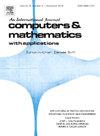衰减Burgers湍流的近似反褶积和速度估计模型
IF 2.9
2区 数学
Q1 MATHEMATICS, APPLIED
引用次数: 0
摘要
本文介绍了用大涡模拟(LES)方法模拟的Burgers湍流。采用了两种子滤波模型:近似反褶积模型(ADM)和速度估计概念(VEC)。在ADM方法中,通过与直接反演方法的比较,应用了两种不同类型的滤波器,表明了滤波器对反褶积收敛的影响。在这两种方法中,ADM和VEC都显示了反卷积和估计域。强调ADM引入了以子滤波尺度为特征的流结构,直至网格截止长度尺度。在VEC的情况下,仅应用运动步进进行子网格速度场估计。我们观察到,在空间分辨率足够的情况下,ADM和VEC都提供了与直接数值模拟(DNS)密切相关的预测。此外,基于顶帽滤波器作为LES基础的结果与基于六阶pad本文章由计算机程序翻译,如有差异,请以英文原文为准。
Approximate deconvolution and velocity estimation modeling of decaying Burgers turbulence
The paper presents Burgers turbulence simulated using Large Eddy Simulations (LES). Two types of subfilter models are applied: Approximate Deconvolution Model (ADM) and Velocity Estimation Concept (VEC). In the ADM approach, two different filter types were applied indicating the influence of the filter on the deconvolution convergence via comparison with a direct inversion method. In both approaches the ADM and VEC the deconvolved and estimated fields are shown. It is stressed that ADM introduces flow structures characterized by subfilter scales down to the mesh cut-off length scale. In the case of the VEC only the kinematic step was applied for the subgrid velocity field estimation. We observe that both ADM and VEC provide predictions that are closely related to direct numerical simulations (DNS) provided the spatial resolution is adequate. Moreover, results based on the top-hat filter as the basis for LES are in general agreement with results obtained on the basis of a sixth-order Padé filter. The VEC model provides further opportunities to include much finer scales that evolve under simplified approximate dynamics, thereby enabling additional fine-tuning of the predictions of higher-order statistical quantities.
求助全文
通过发布文献求助,成功后即可免费获取论文全文。
去求助
来源期刊

Computers & Mathematics with Applications
工程技术-计算机:跨学科应用
CiteScore
5.10
自引率
10.30%
发文量
396
审稿时长
9.9 weeks
期刊介绍:
Computers & Mathematics with Applications provides a medium of exchange for those engaged in fields contributing to building successful simulations for science and engineering using Partial Differential Equations (PDEs).
 求助内容:
求助内容: 应助结果提醒方式:
应助结果提醒方式:


